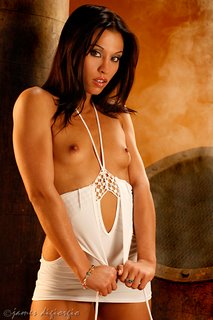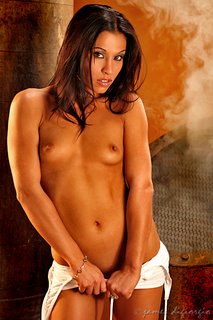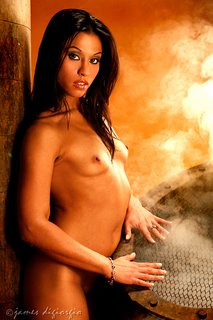 I've gotten to the point (when I look at glamour images) where I find myself making immediate decisions whether to classify the image's creator predominantly a photographer or a photoshopographer, at least in terms of a specific image or set of images.
I've gotten to the point (when I look at glamour images) where I find myself making immediate decisions whether to classify the image's creator predominantly a photographer or a photoshopographer, at least in terms of a specific image or set of images. Don't get me wrong, I'm not a photo-elitist. I don't frown or look down on those who use Photoshop or other image processing tools as "lesser folks" in the world of glamour photography. I do think, however, there are far too many shooters who overly rely on post-processing to "save" or "improve" an image. But then, there are also those who wield image processors like true artists.
When I first decided to upgrade my post-processing skills (in a serious way) I found myself over-using the powerful processing tools included in Photoshop. Like many other shooters, I applied tools like Gaussian Blur, Diffuse Glow, Unsharp Mask, and others with a heavy hand. The more I learned, the more I went a little crazy using these tools. In retrospect, I don't think I always improved my images, I simply made them look artificial and the models doll-like.
 That's not to say there aren't artists who create wonderful images even if they seem more image-processed than photographically-created. My PS skills haven't achieved a level of skill that many possess and I'm not sure my artistic abilities will ever allow me to create some of the kinds of incredible images I often see, but then, I'm a shooter, a photographer, not a digital graphic artist.
That's not to say there aren't artists who create wonderful images even if they seem more image-processed than photographically-created. My PS skills haven't achieved a level of skill that many possess and I'm not sure my artistic abilities will ever allow me to create some of the kinds of incredible images I often see, but then, I'm a shooter, a photographer, not a digital graphic artist.Since the advent of digital photography and processing, there's been a virtual rennaisance of photo-inspired art, albeit digital art. Digital artists who combine photographic images and digital processing often treat us to a world of creative imagery that is as imaginative as it is wonderous to view.
 Simple, mortal, glamour photographers, on the other hand, use these digital tools to fix mistakes, enhance certain photographic aspects of an image, hide a model's imperfections and attempt to further beautify the model by manipulating her digitally-captured image. That sounds reasonable. After all, we long for perfection. And, as some say, Reality sucks!
Simple, mortal, glamour photographers, on the other hand, use these digital tools to fix mistakes, enhance certain photographic aspects of an image, hide a model's imperfections and attempt to further beautify the model by manipulating her digitally-captured image. That sounds reasonable. After all, we long for perfection. And, as some say, Reality sucks! So what's wrong with manipulating reality? I suppose nothing as long as its done well and in ways that maintain some semblance of reality, i.e., the model still looks, for the most part, like a mostly real person. (At least, in the context of glamour photography.) I have no problem "suspending disbelief" except when people sometimes make if overly hard to do so.
I captured the images accompanying this post yesterday. Model is Jana (pronounced "Jay-nuh")and her exotic "look" is courtesy of a Malaysian mother and an Irish father. MUA was Lydia. Assistant (my Aziz for the day) was Fonzie. Images captured with a Canon 5D w/85mm f/1.8 prime, ISO 100, f/4.5 @ 125th. Photoshop processing was applied sparingly although I think a good graphic artist could have some fun with the production elements contained in the images from this series.
Below is a behind-the-scenes image of the set and lighting. Fonzie is crouched off to the side, working the controls of the fog machine that's hidden inside the faux steam vent. One of the lighting sources is barely in the frame at all: the overhead-boomed hairlight. But you can see the boom's arm and a little bit of the cinefoil I used to keep its light off the BG.


2 comments:
Striving to get it right in the camera should be the goal, of course. But in my view it would be a mistake to think that that's enough. Creating the final display image--whether for web or print--also requires post-processing skills. And it's no different now than it was in the darkroom. To illustrate this, here's an interesting account of how Ansel Adams created Moonrise Hernandez, one of his most famous photographs.
While I love a good digital art piece, my own philosophy regarding editing images might be summed up as the "Arson Approach." As with arson, if somebody can tell for sure that you did it, you screwed up. :)
That being said, I shoot at 0/0/0 so I can determine the appropriate contrast level, etc, for the image in post. My tweaks are usually small - rarely do I ever add more than three points of contrast - but I almost always do some tweaking. My opinion is that I am smarter than the camera and therefore I should make the decisions.
M
Post a Comment